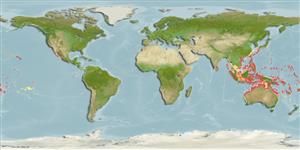>
Blenniiformes (Blennies) >
Tripterygiidae (Triplefin blennies) > Tripterygiinae
Etymology: Ceratobregma: Greek, keras = horn + Greek, bregma = the front of the head (Ref. 45335).
Eponymy: Helen Holleman is the wife of the author; Wouter Holleman. His etymology simply says: “The species I have named for my wife, Helen.” (Ref. 128868), visit book page.
Environment: milieu / climate zone / depth range / distribution range
Ecología
marino asociado a arrecife; rango de profundidad 0 - 40 m (Ref. 27223). Tropical
Pacific Ocean: Christmas Island in the eastern Indian Ocean (Ref. 30874); Taiwan to southwestern and southeastern Australia and American Samoa.
Tamaño / Peso / Age
Maturity: Lm ? range ? - ? cm
Max length : 3.5 cm SL macho / no sexado; (Ref. 54980)
Short description
Claves de identificación | Morfología | Morfometría
Espinas dorsales (total) : 18 - 20; Radios blandos dorsales (total) : 9 - 10; Espinas anales: 2; Radios blandos anales: 19 - 21. Has a reddish head with rose blotches and an olive green body with irregular light streaks and blotches.
Eggs are hemispherical and covered with numerous sticky threads that anchor them in the algae on the nesting sites (Ref. 240). Larvae are planktonic which occur primarily in shallow, nearshore waters (Ref. 94114).
Life cycle and mating behavior
Madurez | Reproducción | Puesta | Huevos | Fecundidad | Larva
Fricke, R., 1994. Tripterygiid fishes of Australia, New Zealand and the southwest Pacific Ocean (Teleostei). Theses Zool. 24:1-585. (Ref. 13227)
IUCN Red List Status (Ref. 130435: Version 2024-2)
Threat to humans
Harmless
Human uses
Pesquerías: sin interés
Herramientas
Special reports
Download XML
Fuentes de Internet
Estimates based on models
Preferred temperature (Ref.
123201): 24.4 - 29, mean 27.8 °C (based on 656 cells).
Phylogenetic diversity index (Ref.
82804): PD
50 = 0.7500 [Uniqueness, from 0.5 = low to 2.0 = high].
Bayesian length-weight: a=0.00617 (0.00288 - 0.01322), b=3.04 (2.86 - 3.22), in cm total length, based on LWR estimates for this (Sub)family-body shape (Ref.
93245).
Nivel trófico (Ref.
69278): 3.1 ±0.3 se; based on size and trophs of closest relatives
Resiliencia (Ref.
120179): Alto, población duplicada en un tiempo mínimo inferior a 15 meses (Preliminary K or Fecundity.).
Fishing Vulnerability (Ref.
59153): Low vulnerability (10 of 100).
Nutrients (Ref.
124155): Calcium = 455 [168, 1,781] mg/100g; Iron = 2.34 [0.84, 5.30] mg/100g; Protein = 18.1 [16.3, 19.8] %; Omega3 = 0.109 [0.027, 0.459] g/100g; Selenium = 73.3 [14.3, 319.4] μg/100g; VitaminA = 43.7 [6.1, 308.1] μg/100g; Zinc = 5.44 [2.43, 10.22] mg/100g (wet weight);
